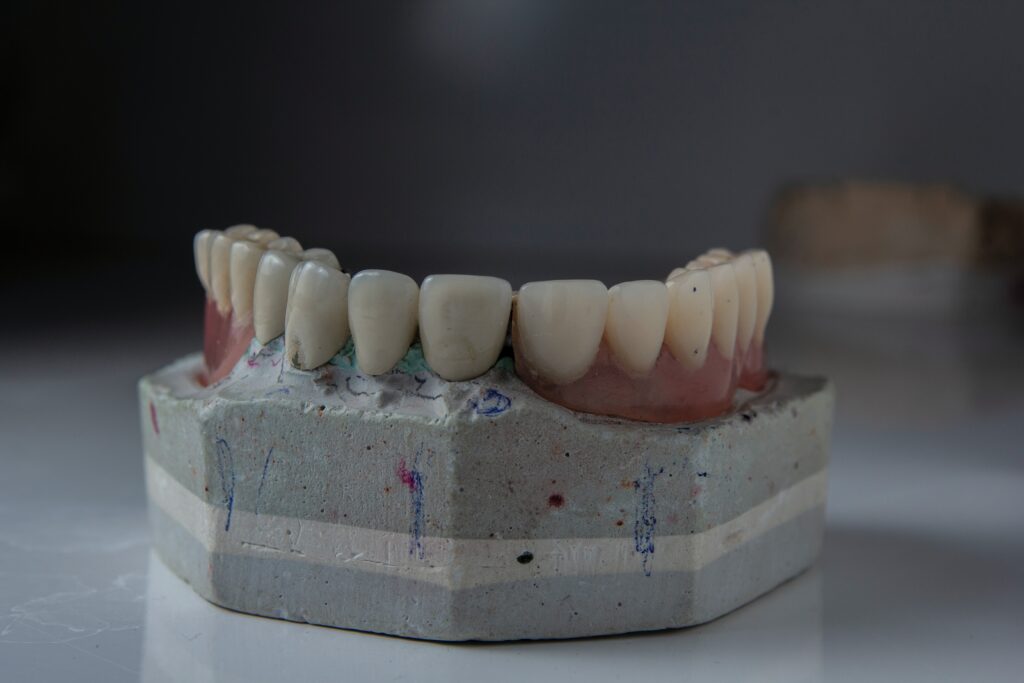
If you’ve been told that you need a root canal, you may have questions about what it entails and why it’s necessary. Let’s dive into the details to give you a clear understanding of root canals.
A root canal is a dental procedure that aims to save a severely damaged or infected tooth. It involves removing the pulp, which is the soft tissue inside the tooth that contains nerves, blood vessels, and connective tissue. Once the infected or damaged pulp is removed, the tooth is cleaned, disinfected, and sealed to prevent further infection.
Root canals are typically performed by dentists who specialize in endodontics, which is the branch of dentistry focused on the diagnosis and treatment of issues related to the tooth’s inner structures. The procedure is usually carried out under local anesthesia to ensure your comfort throughout the process.
A root canal may be necessary in several situations. The most common reasons for needing a root canal include:

Photo by Ozkan Guner on Unsplash
Root canal treatment is essential for several reasons:
It’s important to note that root canal treatment is typically followed by the placement of a dental crown to strengthen and protect the tooth. This ensures that the treated tooth can continue to function effectively for years to come.
By understanding what a root canal is, when it is necessary, and the importance of the treatment, you can approach the procedure with confidence. If you are experiencing any dental pain or suspect that you may need a root canal, it’s crucial to consult with a dental professional who can provide a comprehensive evaluation and guide you through the appropriate treatment. For more information, visit our article on root canal treatment.
If you require a root canal, it’s natural to have questions about the procedure and what it entails. Understanding the steps involved can help alleviate any concerns you may have. The root canal procedure typically involves the following steps:
Before proceeding with a root canal, your dentist will conduct a thorough examination of your tooth. This may involve taking X-rays to assess the extent of the damage and determine if a root canal is necessary. It’s important to address any symptoms you may be experiencing, such as persistent toothache, sensitivity to hot or cold temperatures, or swelling around the affected area. Early detection is key to preventing further complications.
To ensure your comfort throughout the procedure, your dentist will administer a local anesthetic to numb the area surrounding the affected tooth. This will prevent you from feeling any pain or discomfort during the root canal treatment. Your dentist will wait for the anesthetic to take effect before proceeding.
Once the area is numb, your dentist will create a small access hole in the tooth, typically at the back of the tooth or through the crown if necessary. This access point allows the dentist to reach the pulp chamber, which contains the infected or damaged pulp.
Using specialized dental tools, your dentist will carefully clean the pulp chamber and root canals. The infected or damaged pulp will be removed, along with any debris or bacteria. The canals will be shaped and prepared for the filling material. This step is crucial to prevent reinfection and ensure the success of the root canal treatment.
Once the canals are cleaned and shaped, your dentist will fill them with a biocompatible material called gutta-percha. This material seals the canals, preventing bacteria from reentering and causing further infection. In some cases, the dentist may place a temporary filling on top of the gutta-percha to protect the tooth until a permanent restoration, such as a crown, can be placed.
By following these steps, your dentist can effectively treat the infection or damage within your tooth, saving it from extraction and preserving its function. After the root canal procedure, your dentist will provide instructions on post-treatment care and schedule any necessary follow-up visits to monitor your recovery.
For more information on root canals, including the benefits of the treatment and aftercare guidelines, visit our article on root canal treatment.
Undergoing a root canal treatment offers several benefits that can greatly improve your dental health and overall well-being. Let’s explore three key advantages of choosing this procedure.
One of the primary benefits of a root canal treatment is pain relief. When the pulp inside your tooth becomes infected or inflamed, it can cause severe toothache and sensitivity. By removing the infected pulp and cleaning the root canals, a root canal treatment eliminates the source of the pain, providing much-needed relief. After the procedure, you can expect a significant reduction in tooth pain, allowing you to eat, drink, and smile comfortably.
Preserving your natural teeth is crucial for maintaining a healthy and functional smile. A root canal treatment aims to save and restore a tooth that would otherwise need to be extracted. By removing the infected pulp and filling the canals with a biocompatible material, the tooth can be strengthened and protected from further damage. This helps maintain the natural alignment of your teeth and prevents the need for more extensive dental work, such as dental implants or bridges.
When a tooth is infected or damaged, it can significantly impact your ability to chew and speak properly. Pain and sensitivity can make it difficult to eat certain foods, while a missing or severely damaged tooth can affect your speech. By undergoing a root canal treatment, the affected tooth is saved and restored, allowing you to regain proper chewing function and clear speech. This enables you to enjoy a wide range of foods and communicate confidently.
Root canal treatment offers these benefits and more, helping you alleviate pain, preserve your natural teeth, and restore normal dental function. It’s important to note that after the procedure, proper aftercare and recovery is essential to ensure the long-term success of the treatment. This includes managing discomfort and pain, maintaining good oral hygiene, and attending follow-up visits for monitoring. For more information on root canals, visit our article on root canal.
Once you have undergone a root canal treatment, proper aftercare and recovery are essential to ensure the success and longevity of the procedure. Here are the key aspects to focus on during this stage:
It is common to experience some discomfort and mild pain after a root canal procedure. This can be managed with over-the-counter pain medication, such as ibuprofen or acetaminophen, as recommended by your dentist. Applying an ice pack to the affected area for short periods can also help reduce any swelling or discomfort. However, if the pain persists or becomes severe, it is important to contact your dentist for further evaluation and guidance.
Maintaining good oral hygiene is crucial for the success of your root canal treatment. Brush your teeth gently twice a day using a soft-bristled toothbrush and fluoride toothpaste. Additionally, make sure to floss daily to remove any food particles or plaque between your teeth. Using an antimicrobial mouthwash can also help minimize the risk of infection. Remember to avoid chewing on hard or sticky foods that may damage the treated tooth.
After a root canal, it is important to attend your scheduled follow-up visits with your dentist. These visits allow your dentist to monitor your progress, assess the healing process, and make any necessary adjustments. During these appointments, your dentist may take X-rays to check the condition of the treated tooth and ensure that the infection has been completely eradicated. Following your dentist’s instructions and attending these visits is crucial for the long-term success of the root canal treatment.
In case you have any concerns or notice any unusual symptoms, such as persistent pain, swelling, or the recurrence of symptoms, it is important to contact your dentist immediately. Early intervention can mitigate any potential complications and ensure the best possible outcome.
By properly managing discomfort and pain, maintaining excellent oral hygiene, and attending follow-up visits and monitoring, you can optimize your recovery after a root canal treatment. Remember that each individual’s recovery process may vary, and it is important to follow your dentist’s specific instructions for your unique situation.
When it comes to root canals, there are several common myths that can cause unnecessary worry and confusion. Let’s address some of these myths and provide clarity on the facts.
One of the most prevalent misconceptions about root canals is that they are extremely painful. However, this is far from the truth. Modern advancements in dentistry have made root canal procedures much more comfortable and virtually pain-free. Dentists use local anesthesia to numb the area before starting the procedure, ensuring that you remain comfortable throughout. In fact, the purpose of a root canal is to relieve pain caused by an infected or damaged tooth. If you’re experiencing tooth pain, it’s important to seek dental care promptly to address the underlying issue.
Another misconception is that extracting the tooth is a better alternative to undergoing a root canal. While extraction may seem like a quick fix, it is important to consider the long-term implications. Preserving your natural teeth should always be the priority, as they provide proper chewing function, maintain the alignment of surrounding teeth, and prevent bone loss in the jaw. Root canal treatment allows the dentist to remove the infected pulp while saving the natural tooth structure. Once the root canal is complete, a dental crown is often placed to strengthen and protect the tooth, allowing it to function normally for years to come. Extraction should only be considered as a last resort when all other options have been thoroughly explored.
There is a persistent myth that root canals can lead to various health problems. This idea originated from a study conducted in the early 20th century, which has since been thoroughly debunked. Root canal treatment is a safe and effective procedure that eliminates infection and preserves the natural tooth. It does not cause illness or have any systemic effects on the body. In fact, by eliminating the infection, a root canal helps to prevent the spread of bacteria and improves overall oral health.
By dispelling these common myths, we hope to provide you with accurate information about root canals. If you have any further questions or concerns, it’s always best to consult with a dental professional. Remember, root canal treatment is a standard procedure used to save and restore teeth, enabling you to maintain a healthy and beautiful smile.